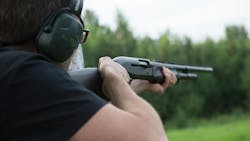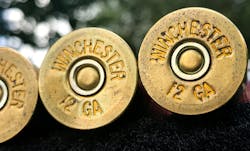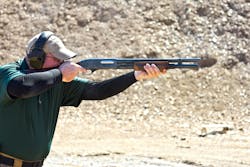Ubiquitous Police Shotgun Still Has Role as Law Enforcement Tool
If you talk to any of the “old guys” around your agency, and ask them about having a shotgun in their patrol vehicle, you’ll find that most of them did—and they miss it if they don’t have it anymore. After the patrol rifle revolution that occurred after or in conjunction with the evolution of active shooter response, shotguns became far less common in patrol vehicles, replaced by a variety of different rifles. At the beginning of the shift, some agencies fought a battle against politicians and the plethora of their outlooks about guns, which resulted in everything from pistol-caliber carbines to semi-auto rifles ending up in trunks or gun racks. Interestingly, shotguns had been in patrol vehicles for so long that none of the politicians even seemed to blink at them—or even think about them at all. We should all be thankful for their lack of knowledge or concern as the shotgun, in pump or semi-auto, can be a far more devastating weapon than many rifles, especially at close range. Thanks to the variety of ammo available for those shotguns, it’s also a far more versatile weapon than any rifle can be.
This article appeared in the January/February issue of OFFICER Magazine. Click Here to subscribe to OFFICER Magazine.
Now, this article isn’t meant to debate whether or not a patrol rifle is “better” than a shotgun or vice versa. Let’s be honest: Which is better is entirely dependent on the circumstances and need at the time. If you need to breech a door, the shotgun (with proper ammo) is better. If you need to engage a threat at 150 yards, the rifle is better. That said, being realistic in most rural environments, engagements will be within 25 yards. In both rural and urban environments, the need to neutralize a rabid or dangerous animal might be equal. Yes, a rifle will work for that, but the shotgun is more forgiving if the animal is on the move.
What are the pain points for a shotgun? It’s easy to identify two. Recoil for most twelve gauge ammo from a pump action shotgun is going to be greater than that of any semi-auto rifle. Reloading the shotgun, unless it’s one of the rare box-fed designs, is much slower than reloading a semi-auto rifle. For the record, weapon design is always evolving and we’ve seen everything from a pump-action tubular-magazine .308 rifle to (now) box-fed .223 lever-action rifles. In day to day law enforcement work, there are often circumstances that would justify having BOTH weapons in your patrol vehicle: One shotgun and one rifle.
One word of warning: don’t justify the possible use of less-lethal ammo to have the shotgun in your patrol vehicle. If you’re going to have a less-lethal shotgun, make it a dedicated less-lethal weapon and mark it as such by changing out “the furniture” (the fore-end and stock) to blaze orange or red, dependent on your agency policy.
Some officers will complain about the weight of a shotgun as compared to an AR-15 or a synthetic stocked pistol-caliber carbine, especially if you start trying to compare round count. An AR-style rifle with a 30-round magazine is still going to be lighter than a shotgun with a magazine tube extension and a side-saddle shell holder. That would still only give you 13 or 14 rounds of 12 gauge and the shotgun will be noticeably heavier. Some have argued that putting a sling on the shotgun makes it easier to manage, and with some techniques that may be true, but put a sling on your AR-style rifle and you get all the same benefits.
Having discussed some of the negatives of having a shotgun for duty use, what are some of the benefits? Let’s start out with the versatility of application, simply due to the wide variety of types of ammo available. If you need a round with lots of punch (and the accompanying higher recoil), slugs are your go to. Few officers who have fired slugs for qualification have a desire to have to trigger them off otherwise. For anti-personnel work or destroying rabid animals, it’s hard to be a double-aught 12 gauge round. Nine .32 caliber pellets (out of a 2.75” shell) say, “Stop trying to kill that person/those people,” pretty well.
If you want to really test your skill, take that slug-barrel shotgun with its 18”-20” barrel, load it with 12-shot and go see how well you do shooting trap or skeet. If you agency authorizes less-lethal 12g, get the appropriate training/certification, change the furniture as described above and use any of the plethora of less-lethal rounds that are available on the market. Load your shotgun with 8-shot and you have one of the best home defense weapons you can think of. Most people will agree: the sound of a shotgun’s action being worked (“racking the shotgun”) is a readily identifiable, unmistakable sound that serves as its own kind of warning to the ne'er-do-wells.
The reality of law enforcement is that a lot of the work is done under no- or low-light conditions. We all know it’s near impossible to hold a shotgun and a flashlight, but there are plenty of after-market fore-ends that either contain a light or allow for mounting a light. Since the ammunition capacity of most shotguns is limited to between five and eight rounds (leaving out Kel-Tec with their dual feed tubes), having extra on the gun is a strength, and there are plenty of after-market options for that as well. Extra rounds in a side-saddle holder on the receiver or a shell-holder on the stock (or both) adds to your available on weapon capacity. Finally, slings are strongly recommended and the options for mounting slings, not to mention the sling designs themselves, are available—again—in wide variety. Do a little research, pick what works for you, and equip your shotgun accordingly.
All in all, when you consider initial purchase costs, the versatility of application and availability of cost-effective ammunition, the shotgun is still hard to beat as a law enforcement long gun. If you no longer have one in your patrol vehicle, or if it had been replaced by a rifle, consider getting another one. The proper tool for the situation should be our rule of equipment selection.
About the Author
Lt. Frank Borelli (ret), Editorial Director
Editorial Director
Lt. Frank Borelli is the Editorial Director for the Officer Media Group. Frank brings 20+ years of writing and editing experience in addition to 40 years of law enforcement operations, administration and training experience to the team.
Frank has had numerous books published which are available on Amazon.com, BarnesAndNoble.com, and other major retail outlets.
If you have any comments or questions, you can contact him via email at [email protected].



